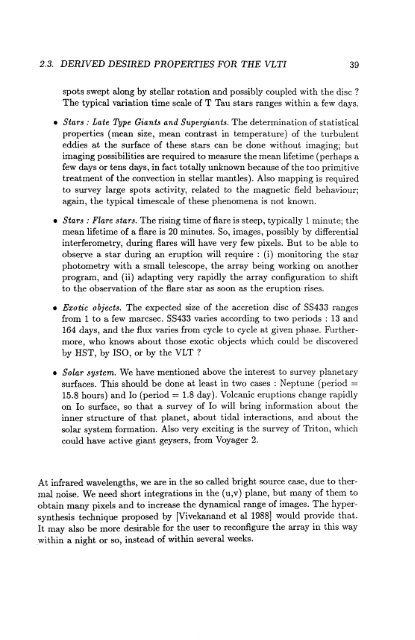The VLT Interferometer - ESO
The VLT Interferometer - ESO
The VLT Interferometer - ESO
Create successful ePaper yourself
Turn your PDF publications into a flip-book with our unique Google optimized e-Paper software.
2.3. DERIVED DESIRED PROPERTIES FOR THE <strong>VLT</strong>I 39<br />
spots swept along by stellar rotation and possibly coupled with the disc?<br />
<strong>The</strong> typical variation time scale of T Tau stars ranges wi thin a few days.<br />
• Stars: Late Type Giants and Supergiants. <strong>The</strong> determination of statistical<br />
properties (mean size, mean contrast in temperature) of the turbulent<br />
eddies at the surface of these stars can be done without imaging; but<br />
imaging possibilities are required to measure the mean lifetime (perhaps a<br />
few days or tens days, in fact totally unknown because of the too primitive<br />
treatment of the convection in stellar mantles). Also mapping is required<br />
to survey large spots activity, related to the magnetic field behaviour;<br />
again, the typical timescale of these phenomena is not known.<br />
• Stars: Flare stars. <strong>The</strong> rising time of flare is steep, typically 1 minute; the<br />
mean lifetime of a flare is 20 minutes. So, images, possibly by differential<br />
interferometry, during flares will have very few pixels. But to be able to<br />
observe a star during an eruption will require: (i) monitoring the star<br />
photometry with a small telescope, the array being working on another<br />
program, and (ii) adapting very rapidly the array configuration to shift<br />
to the observation of the flare star as soon as the eruption· rises.<br />
• Exotic objects. <strong>The</strong> expected size of the accretion disc of SS433 ranges<br />
from 1 to a few marcsec. SS433 varies according to two periods: 13 and<br />
164 days, and the flux varies from cycle to cycle at given phase. Furthermore,<br />
who knows about those exotic objects which could be discovered<br />
by HST, by ISO, or by the <strong>VLT</strong> ?<br />
• Solar system. We have mentioned above the interest to survey planetary<br />
surfaces. This should be done at least in two cases: Neptune (period =<br />
15.8 hours) and 10 (period = 1.8 day). Volcanic eruptions change rapidly<br />
on 10 surface, so that a survey of 10 will bring information about the<br />
inner structure of that planet, about tidal interactions, and about the<br />
solar system formation. Also very exciting is the survey of Triton, which<br />
could have active giant geysers, from Voyager 2.<br />
At infrared wavelengths, we are in the so called bright source case, due to thermal<br />
noise. We need short integrations in the (u,v) plane, but many of them to<br />
obtain many pixels and to increase the dynamical range of images. <strong>The</strong> hypersynthesis<br />
technique proposed by [Vivekanand et al 1988] would provide that.<br />
It may also be more desirable for the user to reconfigure the array in this way<br />
within a night or so, instead of within several weeks.

















